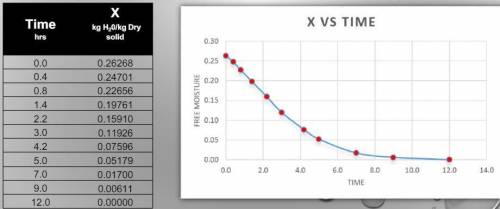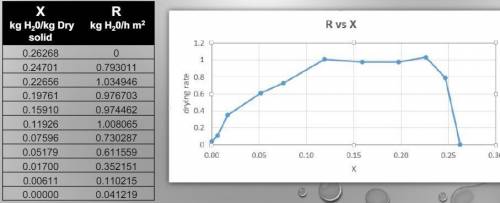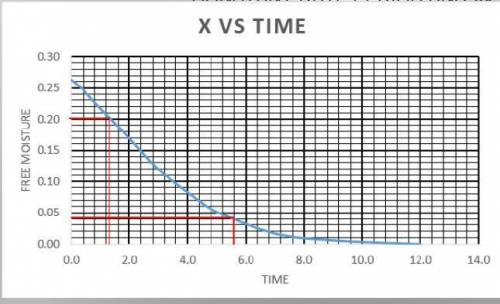
Engineering, 03.03.2020 21:51 alexportillo859
In order to test the feasibility of drying a certain foodstuff, drying data were obtained in a tray dryer with air flow over the top exposed surface having an area of 0.186 m2. The bone dry sample weight was 3.765 kg dry solid. At equilibrium after a long period, the wet sample weight was 3.955 kg (water plus solid). Hence, 3.955-3.765 or 0.190 kg of equilibrium moisture was present. The following table provides the sample weights versus time during the drying test:
Time (hr)
Weight (kg)
Time (hr)
Weight (kg)
Time (hr)
Weight (kg)
0
4.944
2.2
4.554
7.0
4.019
0.4
4.885
3.0
4.404
9.0
3.978
0.8
4.808
4.2
4.241
12.0
3.955
1.4
4.699
5.0
4.150
A) Calculate the free moisture content, X (kg water per kg dry solid) for each data point and plot X versus t;
B) Using the slope, calculate the drying rate, R in kg water per hour per square meter and plot R versus X;
C) Using this drying rate curve, predict the total time to dry the sample from X = 0.20 to X = 0.04. Use numerical integration in the falling rate period. What is the drying rate in the constant rate period and what is X in the constant rate period?

Answers: 2
Another question on Engineering

Engineering, 03.07.2019 14:10
Explain the difference laminar and turbulent flow. explain it with the shear stress and the velocity profiles.
Answers: 1

Engineering, 04.07.2019 18:10
An air conditioning system consist of a 5 cm diameter pipe, operating at a pressure of 200 kpa. the air initially enters the pipe at 15°c with a velocity of 20 m/s and relative humidity of 80%. if the heat supply throughout the process is 960 w, determine the relative humidity and the temperature at the outlet
Answers: 3

Engineering, 04.07.2019 18:10
Apipe with an outside diameter of 15 cm is exposed to an ambient air and surrounding temperature of -20°c. the pipe has an outer surface temperature of 65°c and an emissivity of 0.85. if the rate of heat loss from the pipe surface is 0.95 kw per meter of length, the external convective heat transfer coefficient (h) is: (a) 12.5 w/m"k (b) 18.6 w/mk (c) 23.7 w/mk (d) 27.9 w/mk (e) 33.5 w/mk
Answers: 1

Engineering, 04.07.2019 18:10
Slip occurs via two partial dislocations because of (a) the shorter path of the partial dislocation lines; (b) the lower energy state through partial dislocations; (c) the charge balance.
Answers: 1
You know the right answer?
In order to test the feasibility of drying a certain foodstuff, drying data were obtained in a tray...
Questions

History, 09.04.2020 05:04





Chemistry, 09.04.2020 05:05

Mathematics, 09.04.2020 05:05




Mathematics, 09.04.2020 05:05

Mathematics, 09.04.2020 05:05

Mathematics, 09.04.2020 05:05

Biology, 09.04.2020 05:05

English, 09.04.2020 05:05




Mathematics, 09.04.2020 05:05

History, 09.04.2020 05:05






